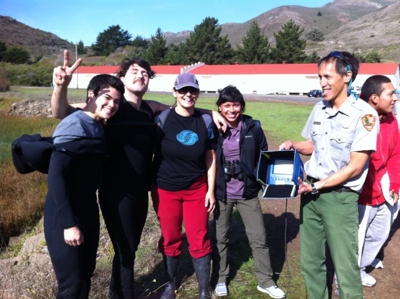Downtown High School Heads to Rodeo Lagoon to Help the Tidewater Goby
On Friday, students from Downtown High School joined Wild Equity for a trip to Rodeo Lagoon to see and take action to save the endangered Tidewater Goby. This small aquatic species is listed under the endangered species act because of a significant declined in its population, mainly due to habitat destruction and invasive species. The fish is found in only a small portion of its native habitat; it is unfortunately no longer found in San Francisco.
The students learned about the Tidewater Goby’s fragile state and took action to help protect the species. Darren Fong, Aquatic Ecologist for The Golden Gate National Recreation Area, gave a talk about the history of Rodeo Lagoon and showed the students the Tidewater Goby with a special underwater camera.

Darren Fong showing students a seine that will collect fish samples.

Researchers collecting samples with a seine in Rodeo Lagoon.
The students even had a chance to be field biologists for the day! Karen Crow, Assistant Professor at San Francisco State University, who studies the Three-spined stickleback for its evolutionary and genetic traits, taught the students useful sampling techniques. The Three-spine stickleback were collected from the lagoon with seines and transported into buckets where the students measured them to determine which ones would be valuable for further research.

Students measuring the Three-spined stickleback.
The students were also presented with the opportunity to engage in critical habitat restoration. They worked with James Cartan, from the National Park Service, removing invasive ice plant along the lagoon shoreline.

Students removing invasive ice plants.
We all had a wonderful time with the students on this trip. It was a great opportunity to learn about the ecology of Rodeo Lagoon, habitat restoration, and receive hands-on experience, which helped create a positive difference for the sensitive species at Rodeo Lagoon.

The Tidewater Goby

Field biologists, and Darren Fong, with the underwater camera.
You can also help create sustainable communities and protect native species by volunteering with us, becoming a member, or donating on-line today!



Leave a Reply
Want to join the discussion?Feel free to contribute!